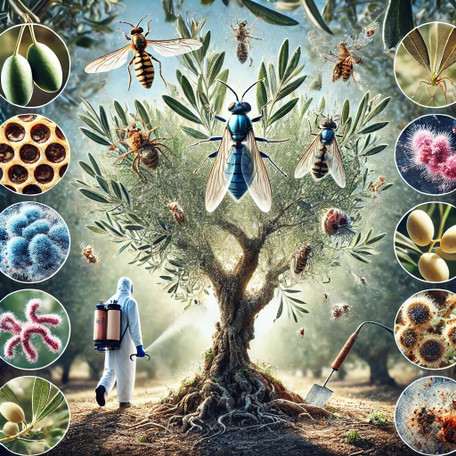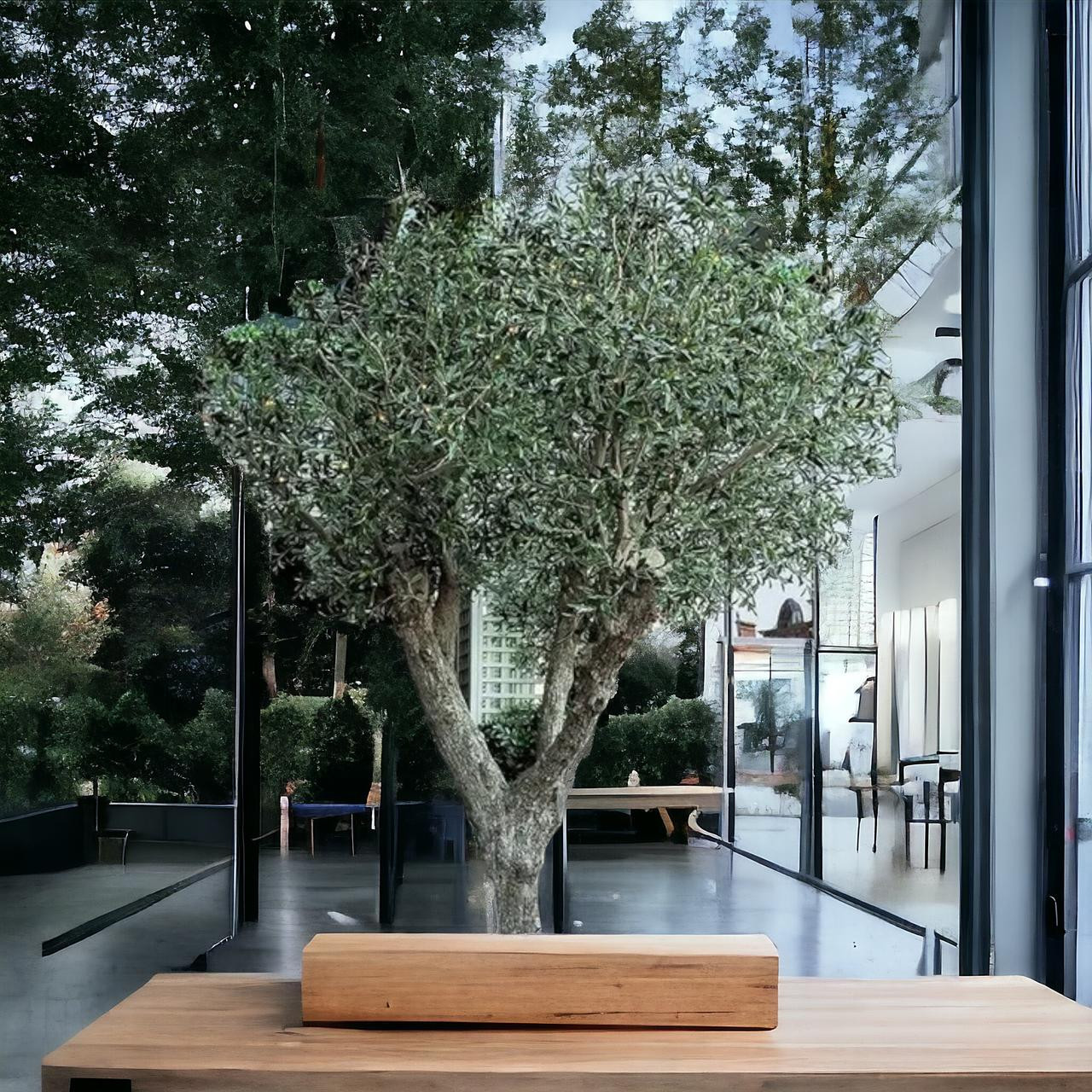Olive Tree Diseases and Pests: Prevention and Treatment
Aug 10, 2024
Olive Tree Diseases and Pests: Prevention and Treatment
Ah, the olive tree! A symbol of peace, wisdom, and a splash of extra virgin joy on your salad. But, my dear friends, let me tell you, cultivating these ancient marvels is not always as serene as the landscapes they often grace. The olive tree, with its twisted trunk and silver-green leaves, may appear resilient, but it is not immune to the various ailments and critters that seek to undo its majesty. Today, I’m going to take you on a wild journey through the world of olive tree diseases and pests—complete with eccentric insights, peculiar prevention strategies, and treatment options that would make even the most skeptical gardener nod in approval.
The Pests That Pester
Let’s kick things off with the villains of our story: the pests. These little rascals can turn your peaceful olive grove into a battleground if not managed properly. But fear not! With a bit of cunning and a dash of persistence, you can outsmart these invaders.
1. Olive Fruit Fly (Bactrocera oleae)
Ah, the olive fruit fly—a menace of Mediterranean proportions! This tiny fly, with its sinister black body and reddish eyes, lays its eggs inside the developing olive fruit. The larvae, or maggots if you prefer a more visceral term, feast on the flesh of the olive, leaving it blemished, soft, and utterly unusable for producing that liquid gold we cherish.
Prevention and Treatment:
- Timing Is Everything: The key to managing olive fruit flies is to act before they strike. Monitor your trees closely during the fruiting season. Set out traps laced with pheromones to catch these fiendish flies before they can lay eggs. These traps are particularly effective when deployed early in the season.
- Cover Them Up: For smaller orchards or individual trees, consider using fine mesh bags to cover the fruit clusters. This physically prevents the flies from reaching the olives, effectively safeguarding your crop.
- Organic Control: If you’re like me and prefer to keep things au naturel, introduce parasitic wasps into your garden. These tiny warriors prey on the olive fruit fly larvae, helping to keep the population in check. Neem oil sprays can also deter the flies, but be careful to apply them in the early morning or late evening to avoid harming beneficial insects.
2. Olive Moth (Prays oleae)
The olive moth is another unwelcome guest in the olive grove. This pest has three generations a year, each one targeting a different part of the tree: the flowers, the young fruit, and finally, the leaves. If left unchecked, the olive moth can cause significant damage to both the tree’s structure and its yield.
Prevention and Treatment:
- Biological Warfare: Bacillus thuringiensis (Bt), a naturally occurring bacterium, is a fantastic weapon against olive moths. Apply Bt sprays during the flowering period to target the larvae before they can do too much damage. It’s a bit like sending in a microscopic army to do your bidding!
- Encourage Natural Predators: Lacewings and predatory beetles are the nemeses of the olive moth. Encourage these helpful creatures by planting companion plants like dill, fennel, and yarrow, which attract them to your garden.
- Monitor and Destroy: Regularly inspect your trees for signs of olive moth infestation, such as webbing on the leaves or small holes in the fruit. If you find infested parts, prune and destroy them to prevent the pests from spreading.
3. Scale Insects (Saissetia oleae)
These sneaky little sap-suckers can be found clinging to the bark and leaves of your olive tree. Scale insects may be small, but in large numbers, they can weaken the tree, making it more susceptible to disease. Not to mention, their sticky honeydew secretion is a magnet for sooty mold, which can further hinder the tree’s ability to photosynthesize.
Prevention and Treatment:
- Prune and Purge: Regular pruning to improve air circulation and sunlight penetration can help keep scale populations in check. Be sure to remove any heavily infested branches.
- Beneficial Insects: Ladybugs and parasitic wasps are the natural predators of scale insects. Encourage these helpful allies by planting nectar-rich flowers nearby, such as marigolds and daisies.
- Horticultural Oil: Apply horticultural oil sprays during the dormant season to smother the scale insects and their eggs. Be sure to thoroughly coat the trunk, branches, and leaves to ensure maximum effectiveness.
4. Olive Lace Bug (Froggattia olivinia)
The olive lace bug is a relatively new pest on the scene, but it’s already causing quite a stir. These small, flat, brownish insects suck the sap from the leaves, causing yellowing, browning, and eventual leaf drop. Left unchecked, they can weaken the tree and reduce its ability to produce fruit.
Prevention and Treatment:
- Early Detection: Regularly inspect the undersides of leaves for lace bug infestations. The sooner you catch them, the easier they are to control.
- Natural Predators: Birds, spiders, and predatory insects like ladybugs can help keep lace bug populations in check. Create a diverse garden habitat to encourage these natural predators.
- Neem Oil: Neem oil sprays can be effective against lace bugs, particularly when applied during the early stages of infestation. Reapply as needed, but be mindful of beneficial insects.
The Diseases That Afflict
Now, onto the diseases that can bring even the most robust olive tree to its knees. These ailments can be tricky to diagnose and treat, but with a keen eye and a proactive approach, you can keep your trees healthy and thriving.
1. Olive Knot (Pseudomonas savastanoi pv. savastanoi)
Olive knot is a bacterial disease that causes unsightly galls or “knots” to form on the branches, twigs, and even the trunk of the tree. These galls can range in size from small, pea-sized lumps to large, tumor-like growths. If left untreated, olive knot can weaken the tree, reduce fruit production, and eventually kill it.
Prevention and Treatment:
- Sanitation, Sanitation, Sanitation: Always sanitize your pruning tools before and after working on your olive trees. This simple step can prevent the spread of the bacteria that causes olive knot.
- Prune Carefully: If you spot galls on your tree, prune them out immediately, making sure to cut well below the affected area. Dispose of the pruned material far away from your garden to prevent reinfection.
- Copper-Based Sprays: Apply copper-based bactericides during the dormant season to help prevent the spread of olive knot. This treatment is particularly effective if applied after pruning or during wet weather, when the bacteria are most active.
2. Verticillium Wilt (Verticillium dahliae)
Verticillium wilt is a soil-borne fungal disease that can be devastating to olive trees. The fungus infects the tree’s vascular system, causing the leaves to wilt, turn yellow, and eventually drop off. In severe cases, entire branches or even the whole tree can die.
Prevention and Treatment:
- Avoid Contaminated Soil: The best way to prevent verticillium wilt is to avoid planting olive trees in soil that is known to be contaminated with the fungus. If you suspect your soil may be infected, consider planting resistant rootstocks or opting for raised beds with fresh, sterile soil.
- Improve Soil Health: A healthy, well-drained soil with plenty of organic matter can help your olive tree resist verticillium wilt. Regularly amend your soil with compost and avoid overwatering, which can exacerbate the disease.
- Remove Infected Branches: If you notice signs of verticillium wilt on your tree, prune out the affected branches immediately. Burn or dispose of the pruned material to prevent the spread of the fungus.
3. Peacock Spot (Spilocaea oleaginea)
Peacock spot, also known as olive leaf spot, is a fungal disease that causes dark, circular spots to form on the leaves, resembling the eye pattern on a peacock’s feathers—hence the name. This disease can lead to premature leaf drop, which weakens the tree and reduces its ability to produce fruit.
Prevention and Treatment:
- Copper Sprays: Copper-based fungicides are effective against peacock spot. Apply them in the autumn, before the onset of the rainy season, and again in the spring if needed.
- Improve Air Circulation: Prune your olive trees to improve air circulation within the canopy. This reduces the humidity levels that favor the development of peacock spot.
- Clean Up Fallen Leaves: Remove and destroy fallen leaves from around the base of the tree, as they can harbor the fungal spores that cause peacock spot.
4. Root Rot (Phytophthora spp.)
Root rot is a serious fungal disease that affects the roots of the olive tree, leading to poor growth, yellowing leaves, and eventual death if not addressed. The fungus thrives in waterlogged soils, making proper drainage essential for preventing this disease.
Prevention and Treatment:
- Ensure Good Drainage: The best way to prevent root rot is to plant your olive trees in well-drained soil. If your soil is heavy or clayey, consider planting on a raised mound or in a container with good drainage.
- Avoid Overwatering: Olive trees are drought-tolerant and prefer to dry out between waterings. Overwatering can create the perfect conditions for root rot to take hold.
- Fungicide Treatment: If you suspect root rot, drench the soil around the tree with a fungicide that targets Phytophthora species. Be sure to follow the instructions carefully, as overuse of fungicides can harm the tree.
5. Sooty Mold
Sooty mold is not a disease per se, but rather a fungal growth that occurs on the surfaces of leaves, stems, and fruit. It is often associated with the presence of sap-sucking insects like scale or aphids, which excrete honeydew—a sticky substance that provides the perfect breeding ground for the mold. While sooty mold doesn’t directly harm the tree, it can block sunlight from reaching the leaves, reducing photosynthesis and weakening the tree.
Prevention and Treatment:
- Control Insects: Since sooty mold is a secondary issue caused by insect infestations, controlling the insect population is key to preventing it. Use the methods mentioned earlier to keep scale, aphids, and other sap-suckers at bay.
- Clean the Leaves: If sooty mold has already taken hold, you can gently wash the affected leaves with a mixture of water and mild soap. This will remove the mold and allow the leaves to function properly again.
- Prune for Airflow: Increasing air circulation within the tree’s canopy can help reduce the humidity levels that encourage sooty mold growth.
A Few Quirky Tips from an Eccentric Gardener
Now that we’ve covered the main pests and diseases that afflict olive trees, I’d like to share a few unconventional tips that I’ve picked up over the years. These might raise an eyebrow or two, but trust me, they work!
1. Coffee Grounds and Eggshells
Don’t throw away those coffee grounds and eggshells! Both can be beneficial to your olive tree. Coffee grounds, when sprinkled around the base of the tree, can deter pests like ants and slugs. They also add a bit of nitrogen to the soil, which is always a plus.
Eggshells, on the other hand, are rich in calcium, which can help strengthen the tree’s cell walls and improve its resistance to disease. Crush the shells into small pieces and scatter them around the tree’s base. As they break down, they’ll slowly release their nutrients into the soil.
2. Music for the Soul
This one’s a bit out there, but I’ve found that playing classical music in the garden can have a positive effect on my olive trees. Whether it’s the soothing sounds of Mozart or the lively rhythms of Vivaldi, the vibrations seem to stimulate growth and keep pests at bay. At the very least, it makes the time you spend tending to your trees even more enjoyable.
3. Companion Planting
Companion planting is a time-honored gardening practice that involves planting certain species together to benefit one another. For olive trees, consider planting lavender, rosemary, or thyme nearby. Not only do these herbs thrive in similar conditions, but their strong scents can also deter pests and attract beneficial insects. Plus, you’ll have a ready supply of fresh herbs to use in your kitchen!
Conclusion
There you have it—a comprehensive (and slightly quirky) guide to preventing and treating the common pests and diseases that can afflict your olive trees. Remember, the key to success lies in vigilance, proper care, and a willingness to try new things. Olive trees may be ancient and resilient, but they still require a little love and attention to stay healthy and productive.
So go forth, my fellow gardeners, armed with knowledge and a healthy dose of eccentricity! Whether you’re battling olive fruit flies, fending off scale insects, or simply trying to keep your trees free from sooty mold, I hope this guide has provided you with the tools and inspiration you need to succeed.
And don’t forget—gardening is as much about enjoying the process as it is about the results. So put on some music, brew a cup of coffee, and spend some quality time with your olive trees. They’ll reward you with their beauty, their fruit, and the satisfaction of a job well done. Happy gardening!





